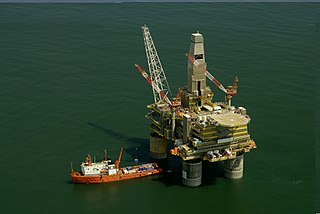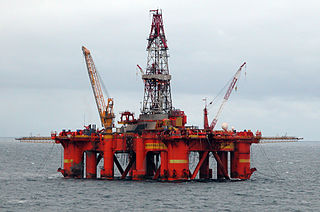
An oil platform is a large structure with facilities to extract and process petroleum and natural gas that lie in rock formations beneath the seabed. Many oil platforms will also have facilities to accommodate the workers, although it is also common to have a separate accommodation platform linked by bridge to the production platform. Most commonly, oil platforms engage in activities on the continental shelf, though they can also be used in lakes, inshore waters, and inland seas. Depending on the circumstances, the platform may be fixed to the ocean floor, consist of an artificial island, or float. In some arrangements the main facility may have storage facilities for the processed oil. Remote subsea wells may also be connected to a platform by flow lines and by umbilical connections. These sub-sea facilities may include one or more subsea wells or manifold centres for multiple wells.

The Troll A platform is a Condeep gravity-based structure offshore natural gas platform in the Troll gas field off the west coast of Norway. Built from reinforced concrete, as of 2014, it was the tallest structure that has ever been moved to another position, relative to the surface of the Earth, and is among the largest and most complex engineering projects in history. The platform was a televised sensation when it was towed into the North Sea in 1995, where it is now operated by Equinor. It is also the heaviest object moved and the object with the second highest displacement at 1.2 million tons(the object with the highest displacement is the Gullfaks C, which had a displacement approaching 1.5 million tons in comparison with Troll A's 1.2 million). Troll A was towed from the afternoon 10 May 1995 until the platform was in place 17 May 1995. It was lowered to the seabed in 303 meters of water, and had penetrated 36 meters into the soil by 19 May 1995. It was self-supporting with no further mooring required.

A semi-submersible platform is a specialised marine vessel used in offshore roles including as offshore drilling rigs, safety vessels, oil production platforms, and heavy lift cranes. They have good ship stability and seakeeping, better than drillships.

Ormen Lange is a natural gas field on the Norwegian continental shelf. It is situated 120 kilometres (75 mi) northwest of Kristiansund, where seabed depths vary between 800 and 1,100 metres. The field is named after the famous longship Ormen Lange of Olaf Tryggvason, a 10th-century Viking king of Norway.

Troll is a natural gas and oil field in the Norwegian sector of the North Sea, one of the biggest in the North Sea, holding 40% of Norway’s gas – it also possesses significant quantities of oil, in thin zones under the gas cap, to the west of the field. The field as a whole consists of the main Troll East and Troll West structures in blocks 31/2, 31/3, 31/5 and 31/6, about 65 kilometres (40 mi) west of Kollsnes, near Bergen. Most of the gas lies in Troll East.

Condeep is a make of gravity-based structure for oil platforms invented and patented by engineer Olav Mo in 1972, which were fabricated by Norwegian Contractors in Stavanger, Norway. Condeep is an abbreviation for concrete deep water structure. A Condeep usually consists of a base of concrete oil storage tanks from which one, three or four concrete shafts rise. The Condeep base always rests on the sea floor, and the shafts rise to about 30 meters above the sea level. The platform deck itself is not a part of the construction.

Byford Dolphin was a semi-submersible, column-stabilised drilling rig operated by Dolphin Drilling, a Fred Olsen Energy subsidiary. It drilled seasonally for various companies in the British, Danish, and Norwegian sectors of the North Sea. It was registered in Hamilton, Bermuda. In 2019, Dolphin scrapped the rig.

The Saipem 7000 is the world's third largest semi-submersible crane vessel, after the SSCV Sleipnir and the SSCV Thialf. It is owned by the oil and gas industry contractor Saipem S.p.A.

The SSCV Thialf is a huge semi-submersible crane vessel operated by Heerema Marine Contractors; it was the largest crane vessel in the world until the SSCV Sleipnir became the largest in 2019.
This is an overview of Equinor's operations in various countries. Equinor is a Norwegian petroleum company.

Equinor ASA is a Norwegian state-owned multinational energy company headquartered in Stavanger, Norway. It is primarily a petroleum company operating in 36 countries with additional investments in renewable energy. In the 2020 Forbes Global 2000, Equinor was ranked as the 169th-largest public company in the world. In 2023, the company was ranked 52nd in the same list. As of 2021, the company has 21,126 employees.

The Sleipner gas field is a natural gas field in the block 15/9 of the North Sea, about 250 kilometres (160 mi) west of Stavanger, Norway. Two parts of the field are in production, Sleipner West, and Sleipner East (1981). The field produces natural gas and light oil condensates from sandstone structures about 2,500 metres (8,200 ft) below sea level. It is operated by Equinor. The field is named after the eight-legged steed Sleipnir of Odin a widely revered god in Norse mythology.

A jackup rig or a self-elevating unit is a type of mobile platform that consists of a buoyant hull fitted with a number of movable legs, capable of raising its hull over the surface of the sea. The buoyant hull enables transportation of the unit and all attached machinery to a desired location. Once on location the hull is raised to the required elevation above the sea surface supported by the sea bed. The legs of such units may be designed to penetrate the sea bed, may be fitted with enlarged sections or footings, or may be attached to a bottom mat. Generally jackup rigs are not self-propelled and rely on tugs or heavy lift ships for transportation.

A spar is a marine structure, used for floating oil/gas platforms. Named after navigation channel Spar buoys, spar platforms were developed as an extreme deepwater alternative to conventional platforms. The deep draft design of spars makes them less affected by wind, wave, and currents and allows for both dry tree and subsea production.

A floating wind turbine is an offshore wind turbine mounted on a floating structure that allows the turbine to generate electricity in water depths where fixed-foundation turbines are not feasible. Floating wind farms have the potential to significantly increase the sea area available for offshore wind farms, especially in countries with limited shallow waters, such as Spain, Portugal, Japan, France and the United States' West Coast. Locating wind farms further offshore can also reduce visual pollution, provide better accommodation for fishing and shipping lanes, and reach stronger and more consistent winds.
Offshore concrete structures, or concrete offshore structures, are structures built from reinforced concrete for use in the offshore marine environment. They serve the same purpose as their steel counterparts in oil and gas production and storage. The first concrete oil platform was installed in the North Sea in the Ekofisk oil field in 1973 by Phillips Petroleum, and they have become a significant part of the marine construction industry. Since then at least 47 major concrete offshore structures have been built.
Oseberg Øst is an offshore oil field in the North Sea, located east of Oseberg Oil Field. The field was developed with a fixed production, drilling and quarters (PDQ) facility and is operated by Statoil. The first stage phase processing is done at the Oseberg Øst platform. The second and third phase processing of oil is done at the Oseberg Field Center and it is then transported to Sture terminal in Norway through the Oseberg Transport System.
Heimdal is an offshore natural gas field in the North Sea located 212 kilometres (132 mi) northwest of Stavanger, Norway. Heimdal serves as a connection hub for processing and distribution of natural gas from satellite fields.
The Johan Sverdrup oil field is an oil field in the North Sea, about 140 kilometres (87 mi) west of Stavanger, Norway. The field lies in two different production licenses and consists of two different discoveries called Avaldsnes and Aldous Major South. When it was revealed that these discoveries constituted one single field, it was renamed Johan Sverdrup after the father of Norwegian parliamentarism. The field has not yet been unitized between production licenses 501, 501B, and 265. Johan Sverdrup is expected to hold 1.9–3.0 billion barrels of oil. According to Statoil, the field is in 110 to 120 metres water depth, and the reservoir is at 1900 meters depth.

Scarabeo 8 is an ultra deepwater 6th generation semi-submersible drilling rig. It is owned and operated by Saipem. The vessel is registered in Nassau, Bahamas.













